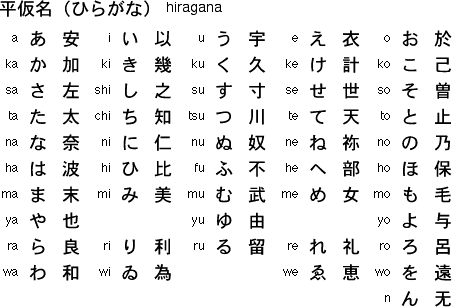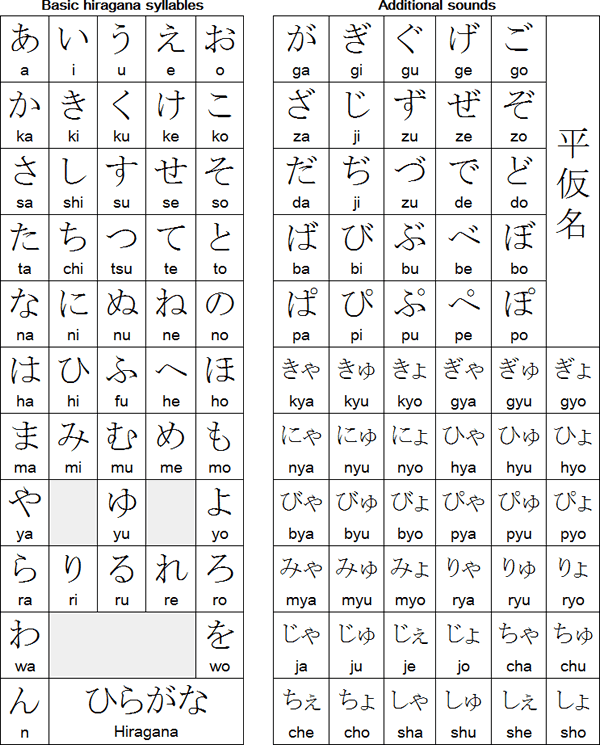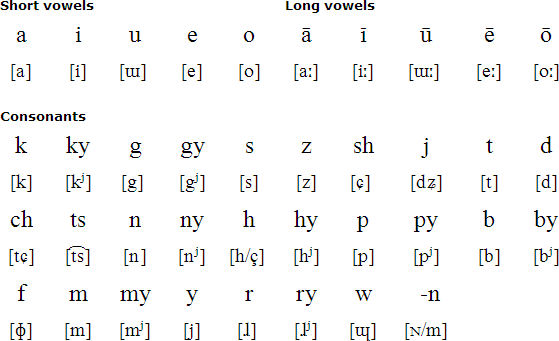Japanese Hiragana
Hiragana syllables developed from Chinese characters, as shown below:
Hiragana were originally called onnade or 'women's hand' as were used mainly by women - men wrote in kanji and katakana. By the 10th century, hiragana were used by everybody. The word hiragana means "oridinary syllabic script". The present orthography of hiragana was codified by the Japanese government in 1946.
Hirgana syllabary (平仮名 / ひらがな)
The symbols on the right are the basic hiragana syllabary in the order they appear in dictionaries and indices (reading from left to right and top to bottom). Additional sounds (the symbols on the right) are represented by diacritics and combinations of symbols.
Long vowels
Characteristics and usage of hiragana
The hiragana syllabary consists of 48 syllables and is mainly used to write word endings, known as okurigana in Japanese. Hiragana are also widely used in materials for children, textbooks, animation and comic books, to write Japanese words which are not normally written with kanji, such as adverbs and some nouns and adjectives, or for words whose kanji are obscure or obselete.
Hiragana are also sometimes written above or along side kanji to indicate pronunciation, especially if the pronunication is obscure or non-standard. Hiragana used in this way are known as furigana or ruby. In horizontal texts, the furigana appear above the kanji and in vertical texts, the furigana appear on the right of the kanji. In newspapers it is a legal requirement for furigana to be attached to kanji which are not included in the official list of the 1,945 most frequently-used kanji. Newspapers in fact rarely use kanji not included in this list.
Caracteres hiragana
| あ a | い i | う u | え e | お o | ゃ ya | ゅ yu | ょ yo |
| か ka | き ki | く ku | け ke | こ ko | きゃ kya | きゅ kyu | きょ kyo |
| さ sa | し shi | す su | せ se | そ so | しゃ sha | しゅ shu | しょ sho |
| た ta | ち chi | つ tsu | て te | と to | ちゃ cha | ちゅ chu | ちょ cho |
| な na | に ni | ぬ nu | ね ne | の no | にゃ nya | にゅ nyu | にょ nyo |
| は ha | ひ hi | ふ fu | へ he | ほ ho | ひゃ hya | ひゅ hyu | ひょ hyo |
| ま ma | み mi | む mu | め me | も mo | みゃ mya | みゅ myu | みょ myo |
| や ya | ゆ yu | よ yo | |||||
| ら ra | り ri | る ru | れ re | ろ ro | りゃ rya | りゅ ryu | りょ ryo |
| わ wa | ゐ wi | ゑ we | を wo | ゐゃ wya | ゐゅ wyu | ゐょ wyo | |
| ん n | |||||||
| が ga | ぎ gi | ぐ gu | げ ge | ご go | ぎゃ gya | ぎゅ gyu | ぎょ gyo |
| ざ za | じ ji | ず zu | ぜ ze | ぞ zo | じゃ ja | じゅ ju | じょ jo |
| だ da | ぢ ji | づ zu | で de | ど do | ぢゃ ja | ぢゅ ju | ぢょ jo |
| ば ba | び bi | ぶ bu | べ be | ぼ bo | びゃ bya | びゅ byu | びょ byo |
| ぱ pa | ぴ pi | ぷ pu | ぺ pe | ぽ po | ぴゃ pya | ぴゅ pyu | ぴょ pyo |




Нема коментара:
Постави коментар